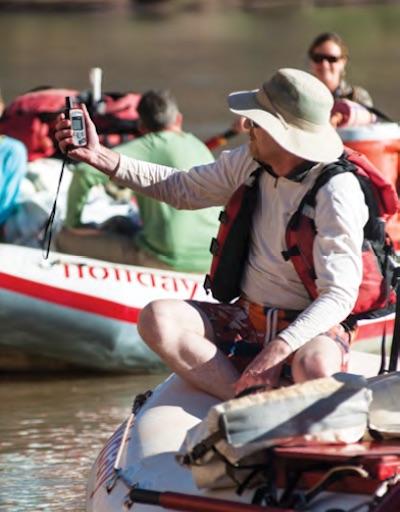
DeLorme's inReach Explorer is a personal locator beacon with the ability to let you create email messages in the field/Patrick Cone
Heading into the backcountry of a national park is not without risk, and so more and more travelers are opting to take some form of personal locator beacon with them. They’re well aware that cellphone coverage can be iffy at best, if not totally non-existent.
Not only do these devices provide a measure of reassurance (you can summon help at the push of a button) but they update your family and friends as to your location, anywhere in the world. One of the best PLBs we’ve tried is DeLorme’s inReach Explorer (MSRP: $379.95). We were able to field test it this fall during a six-day float trip down the Green and Colorado rivers through Canyonlands National Park in southern Utah.
Like others in this category, the Explorer connects you to civilization via satellite. It has an onboard GPS tracking system that lets you map out your journey, an internal tracking system that tells you how long you’ve been on the move, how many miles you’ve covered, and how fast you’re traveling. A compass and altimeter also are built in to the hand-sized unit, and you can even download topographic maps onto it.
Unlike some of the other PLBs we’ve tried, Explorer allows you to send 160-character emails from the field. While there are three preset messages you can load before you head into the wild, this ability to send real-time emails is a huge bonus. And if you really can’t leave civilization behind, you can even launch posts to your Facebook and Twitter followings, and your buddies can even ping the unit to find out where you are.
Now, the Explorer does have some flaws that hopefully DeLorme will address in future models. The biggest issue is the tiny screen: 1.5 inches wide by 1 inch tall, which is difficult to read in sunlight, especially if you wear contact lenses that aim to serve as bifocals. I do, and I simply couldn’t read the screen while wearing them.
The decision to use a text pad set up alphabetically, rather than using the traditional QWERTY keyboard, seemed curious as well. There were problems, too, with such a small screen and my big fingers. But frequent use no doubt will help users overcome some of these issues.
Overall, the ability to send emails from the field, and post to your social channels, make this a great tool to add to your gear, especially if you like to stay in touch while heading into the backcountry. or travel alone. Data plans range from $24.95 for 30 days (nice if you use it infrequently) or the “extreme” plan at $79.95 per month, which will give you an unlimited number of text messages, and allows tracking every two minutes.



Comments
Purchased the Delorme inReach Explorer this past July for our son to take on his solo John Muir Trail hike and it worked great. I used it this past September in the Rocky Mountians when one of our group had a pregnant wife back home in Ky and he was able to text with her everyday. I agree the screen and text pad is small but we pair it with our iPhone and use the phone screen and keypad which work much better. You never have to touch the Delorme except to turn it off and on each night and morning. A great comfort tool to have with the SOS feature. Well worth the money.